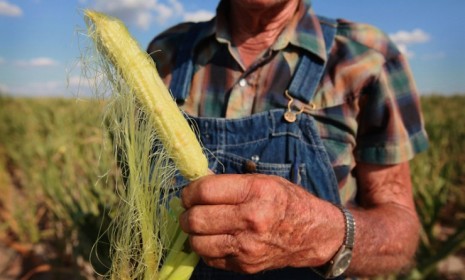Has drought put the U.S. food supply at risk?
One third of the nation's counties are affected by the largest dry spell since 1956, which will likely raise the prices of dairy, grain, produce, and meat

Agriculture Secretary Tom Vilsack had some ominous words for the American public on Wednesday, saying that the severe drought affecting more than half of the country could put the United States' food supply at risk by causing crops to spoil and food prices to spike. Vilsack says it's "the most serious situation" in about 25 years, adding that "if I had a rain prayer or rain dance I could do, I would do it." Here's what you should know about the economic impact the drought will have on the grocery aisle:
How bad is the drought?
Vilsack says that 1,297 counties across the nation have been designated drought disaster areas, or roughly one third overall. It's a "drought of historic proportions," says Reuters. And the footprint of the dry spell is only widening: An additional 39 counties were added to the list on Wednesday, making the overall drought disaster area the largest since 1956. There's no telling yet how much the current drought will cost the U.S. economically; the drought of 1988, which caused forest fires and devastated farmers, is the costliest on record.
The Week
Escape your echo chamber. Get the facts behind the news, plus analysis from multiple perspectives.

Sign up for The Week's Free Newsletters
From our morning news briefing to a weekly Good News Newsletter, get the best of The Week delivered directly to your inbox.
From our morning news briefing to a weekly Good News Newsletter, get the best of The Week delivered directly to your inbox.
Why is it so bad?
Weather conditions for the season actually started off strong, says Vilsack, and "farmers got in the field early." But it seemed just as farmers were preparing to harvest, the drought began to severely hamper their abilities to yield good crops. The drought has come "at a very difficult and painful time," Vilsack says.
What kind of crops are hit the hardest?
About 78 percent of U.S. corn and 11 percent of soybean crops are being affected by the drought, says the AFP. The price of corn has risen 38 percent since June 1, while beans have risen 24 percent. As a result dairy, grain, produce, and meat prices are all about to go way up, affecting the price of everything from chicken to ice cream to pizza. The ramifications will likely be felt globally as well. "The dramatic rise in grain prices in the past few weeks is shaping up to be a serious financial blow for wheat-importing countries," a German trader tells the AFP.
A free daily email with the biggest news stories of the day – and the best features from TheWeek.com
How does this affect me?
Expect prices in the checkout line to rise later this year or early next year, but be wary of any dramatic price increases at your local grocery store in the near-term, says Vilsack. Shopkeepers who raise prices now could just be looking to scam customers by blaming the dry spell.
Sources: AFP, Fox News, Gawker, The New York Times, Telegraph
-
 Farage’s £9m windfall: will it smooth his path to power?
Farage’s £9m windfall: will it smooth his path to power?In Depth The record donation has come amidst rumours of collaboration with the Conservatives and allegations of racism in Farage's school days
-
 The issue dividing Israel: ultra-Orthodox draft dodgers
The issue dividing Israel: ultra-Orthodox draft dodgersIn the Spotlight A new bill has solidified the community’s ‘draft evasion’ stance, with this issue becoming the country’s ‘greatest internal security threat’
-
 Codeword: December 13, 2025
Codeword: December 13, 2025The daily codeword puzzle from The Week